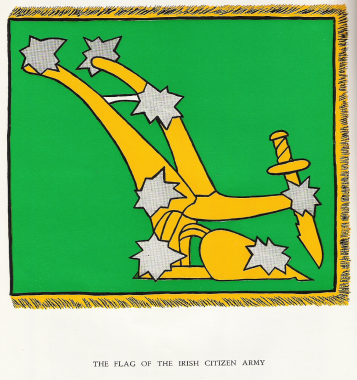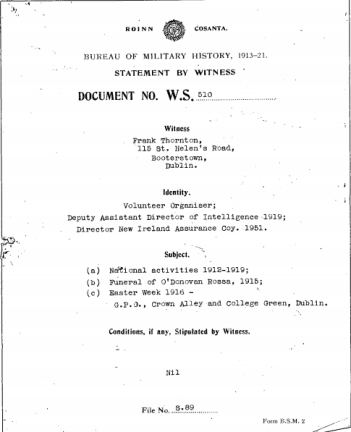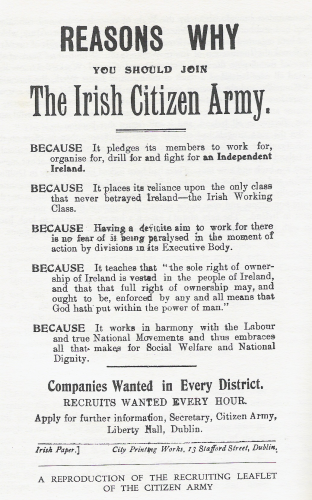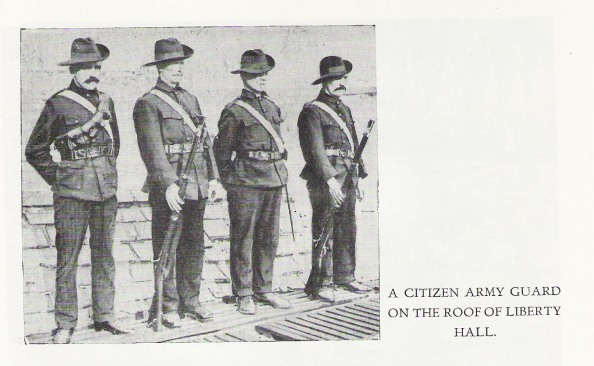The Starry Plough of course was the flag of the Irish Citizen’s Army and it stands to reason then that it was flown high during the 1916 Easter Rising, so I’ve decided to look for mentioning of it in the histories surrounding the Rising. In the military archives in Cathal Brugha Barracks in Rathmines, there is a record of a statement given by one Frank Thornton of Booterstown, Dublin.
As is stated in his statement, Frank Thornton mentions that during the Insurrection he received a request from his commander-in-chief, James Connolly, to erect “The Plough and the Stars” on the Imperial Hotel alongside the Tricolour already flying there. He immediately agreed, and only succeeded after great difficulty as it had to be erected under fire: “but up it went – “The Plough and the Stars” -and there it stayed, altho’ only the front wall of the building remained after the fight had concluded.”
According to his statement, Frank Thornton also says that the men under his command were composed of Citizen Army and 2nd Battalion, Dublin Brigade. He states that his orders were to hold the Imperial Hotel, which was over Clery’s, and right opposite the G.P.O. ,and some neighbouring buildings, until they were blown down by shell fire or burned down. The order concluded: “The British must not occupy these buildings”. Mr Thornton also said that they held those buildings until the walls were falling around them from shells and fires caused by incendiary bombs.
Reading more of Frank Thornton’s statement it quickly becomes clear that this 1916 Rising veteran was a very colourful character who was present at a number of famous instances during the years preceding and after the 1916 Rising. These events have become legendary in Irish history including the funeral of Donovan Rossa, the Lockout, the Howth Gun-running, Volunteer training and smuggling, he was a prisoner in Kilmainham, Mountjoy and Dartmoor after the Rising, he attended the Ashe Funeral, and he also mentions the plan for the rescue of Séan Treacy.
One incident that stands out involves the town of Nenagh and Toomevara. In his statement he said that prior to the 1916 Rising he received permission to take a Walking Tour of the South of Ireland. His statement reads that: “About the middle of January [1916] I got permission to go on a walking tour to the south of Ireland with Sean Hickey. We had strict instructions, however, that we must report at different headquarters on our line of march. We set off on a Tuesday morning with the intention of averaging about 20 odd. miles a day, and all went well until we came to Toomevara in Co. Tipperary. Here the police took a very keen interest in our movements and we were very closely questioned. My name was Frank Drennan and the other man, Sean O’Neill. The police however, were not satisfied with our explanation and we were taken to the barracks, but after about an hour and a half we were released. We informed the police that we were walking to Cork. We started off from Toomevara with the police cycling slowly behind us, and on arrival at Dublin Road, Nenagh, we decided that we would have a meal. We went into what is commonly known down the country, or was at that time, as an “eating house”. After having our meal, we decided to take a chance and ask the good woman of the house if she could assist us by getting us out the back way. We didn’t know this women at all, but as the police were sitting on the window sills of the house opposite, we pointed them out to her and, like many another good Irish woman, she immediately rose to the occasion and arranged with her neighbour in the next street to let us over her garden wall and out through the front door. We left the R.I.C. men still waiting outside while we walked on to Limerick. That was a memorable walk, because we continued walking all night and arrived in Limerick at about 4 o’clock in the morning. Not wanting to draw attention to ourselves, we slipped in the back way on to the station and slept on the seats of the railway station until it was time to ramble down town.”
Frank Thornton’s complete statement can be viewed by clicking this Link!



